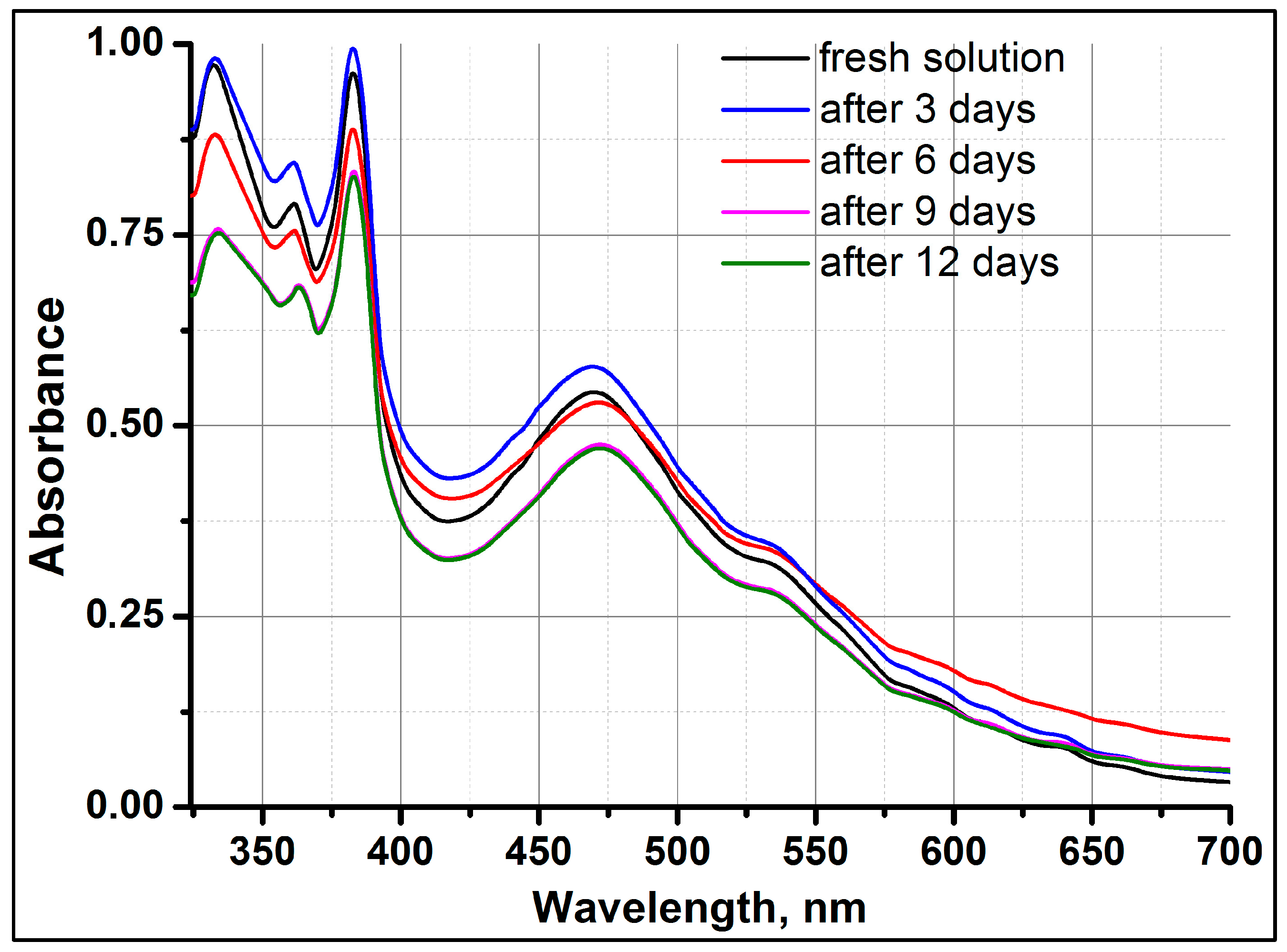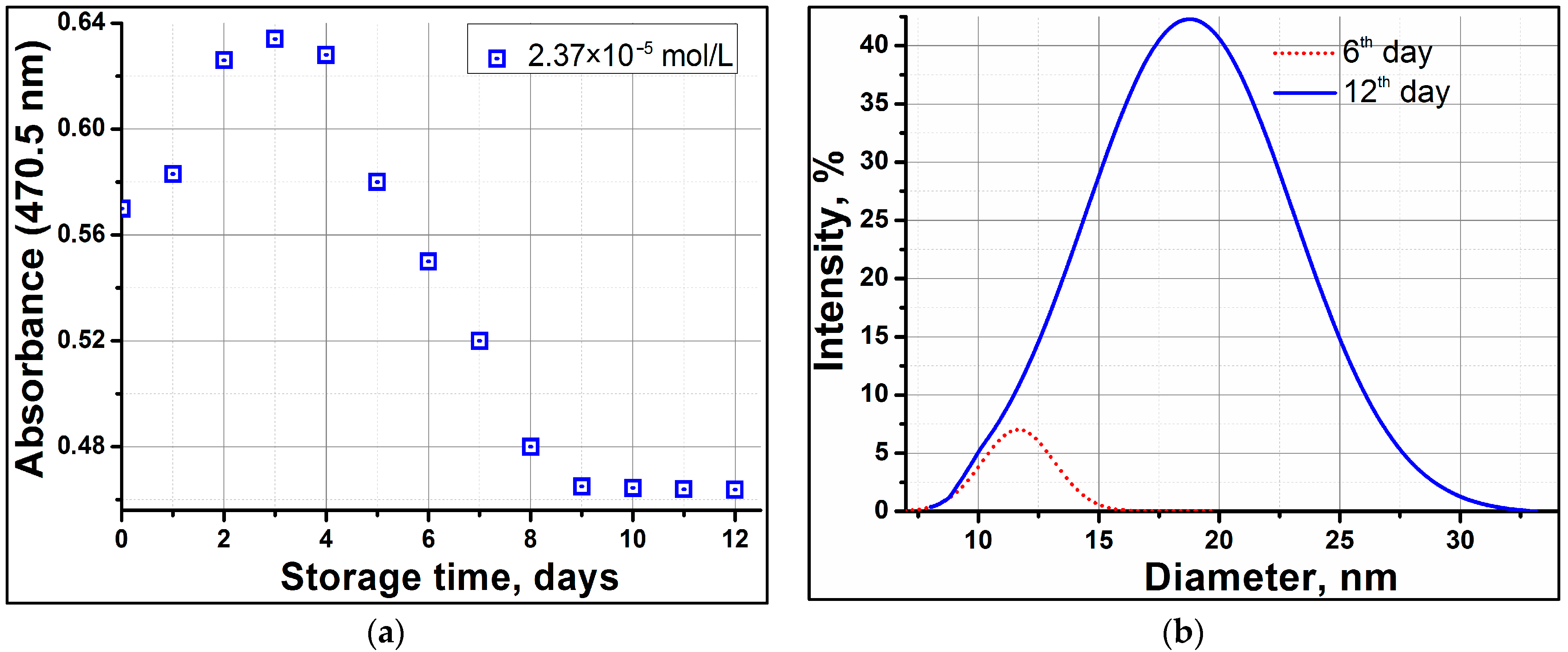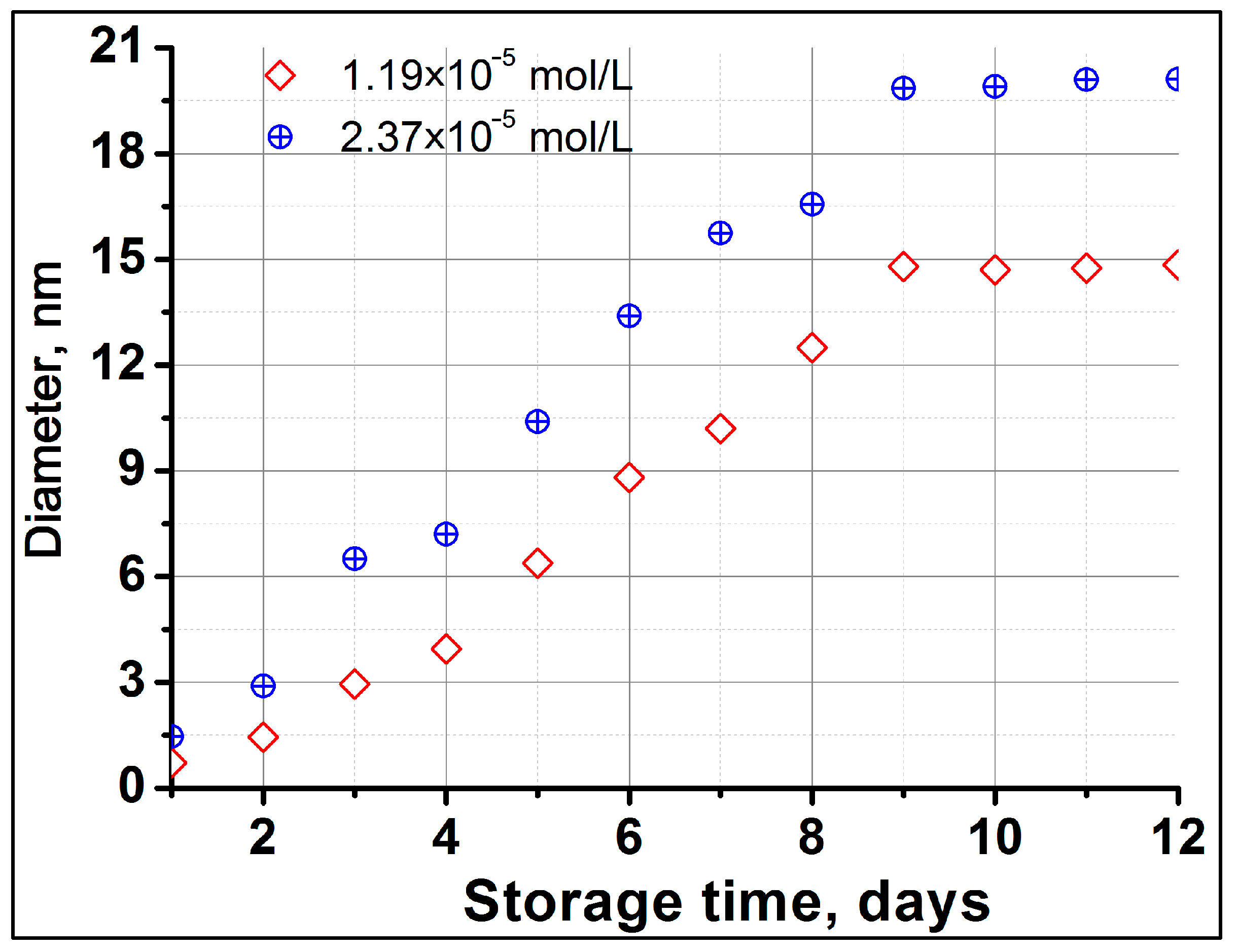Behavior of C70 Fullerene in a Binary Mixture of Xylene and Tetrahydrofuran
Abstract
1. Introduction
2. Materials and Methods
3. Results and Discussion
4. Conclusions
Author Contributions
Funding
Data Availability Statement
Conflicts of Interest
References
- Li, Z.; Wang, L.; Li, Y.; Feng, Y.; Feng, W. Carbon-based functional nanomaterials: Preparation, properties and applications. Compos. Sci. Technol. 2019, 179, 10–40. [Google Scholar] [CrossRef]
- Khan, I.; Saeed, K.; Khan, I. Nanoparticles: Properties, applications and toxicities. Arab. J. Chem. 2019, 12, 908–931. [Google Scholar] [CrossRef]
- Fabbiani, M.; Cesano, F.; Pellegrino, F.; Negri, C. Design, Characterization and Applications of Functional Nanomaterials. Molecules 2021, 26, 7097. [Google Scholar] [CrossRef] [PubMed]
- Joudeh, N.; Linke, D. Nanoparticle classification, physicochemical properties, characterization, and applications: A comprehensive review for biologists. J. Nanobiotechnol. 2022, 20, 262. [Google Scholar] [CrossRef]
- Roduner, E. Size matters: Why nanomaterials are different. Chem. Soc. Rev. 2006, 35, 583–592. [Google Scholar] [CrossRef]
- Georgakilas, V.; Perman, J.A.; Tucek, J.; Zboril, R. Broad Family of Carbon Nanoallotropes: Classification, Chemistry, and Applications of Fullerenes, Carbon Dots, Nanotubes, Graphene, Nanodiamonds, and Combined Superstructures. Chem. Rev. 2015, 115, 4744–4822. [Google Scholar] [CrossRef] [PubMed]
- Kokhkharov, A.M.; Bakhramov, S.A.; Makhmanov, U.K.; Kokhkharov, R.A.; Zakhidov, E.A. Self-induced polarization rotation of laser beam in fullerene (C70) solutions. Opt. Commun. 2012, 285, 2947–2951. [Google Scholar] [CrossRef]
- Saraswati, T.E.; Setiawan, U.H.; Ihsan, M.R.; Isnaeni, I.; Herbani, Y. The Study of the Optical Properties of C60 Fullerene in Different Organic Solvents. Open Chem. 2019, 17, 1198–1212. [Google Scholar] [CrossRef]
- Yablonskaya, O.; Buravleva, E.; Novikov, K.; Voeikov, V. Peculiarities of the Physicochemical Properties of Hydrated C60 Fullerene Solutions in a Wide Range of Dilutions. Front. Phys. 2021, 9, 627265. [Google Scholar] [CrossRef]
- Speranza, G. Carbon Nanomaterials: Synthesis, Functionalization and Sensing Applications. J. Nanomater. 2021, 11, 967. [Google Scholar] [CrossRef]
- Sachdeva, S.; Singh, D.; Tripathi, S.K. Optical and electrical properties of fullerene C70 for solar cell applications. Opt. Mater. 2020, 101, 109717. [Google Scholar] [CrossRef]
- Li, W.; Zhao, T. Hydroxyurea anticancer drug adsorption on the pristine and doped C70 fullerene as potential carriers for drug delivery. J. Mol. Liq. 2021, 340, 117226. [Google Scholar] [CrossRef]
- Upadhyay, R.K.; Kumar, A. A novel approach to minimize dry sliding friction and wear behavior of epoxy by infusing fullerene C70 and multiwalled carbon nanotubes. Tribol. Int. 2018, 120, 455–464. [Google Scholar] [CrossRef]
- Benzigar, M.R.; Joseph, S.; Baskar, A.V.; Park, D.H.; Chandra, G.; Umapathy, S.; Talapaneni, S.N.; Vinu, A. Ordered Mesoporous C70 with Highly Crystalline Pore Walls for Energy Applications. Adv. Funct. Mater. 2018, 28, 1803701. [Google Scholar] [CrossRef]
- Semenov, K.N.; Charykov, N.A.; Keskinov, V.A.; Piartman, A.K.; Blokhin, A.A.; Kopyrin, A.A. Solubility of Light Fullerenes in Organic Solvents. J. Chem. Eng. Data 2010, 55, 13–36. [Google Scholar] [CrossRef]
- Kokhkharov, A.M.; Zakhidov, E.A.; Gofurov, S.P.; Bakhramov, S.A.; Makhmanov, U.K. Clusterization of fullerene C70 molecules in solutions and its influence to optical and nonlinear optical properties of solutions. Int. J. Nanotechnol. 2013, 12, 1350027. [Google Scholar] [CrossRef]
- Tezuka, N.; Umeyama, T.; Matano, Y.; Shishido, T.; Kawasaki, M.; Nishi, M.; Hirao, K.; Lehtivuori, H.; Tkachenko, N.V.; Lemmetyinen, H.; et al. Good Solvent Effects of C70 Cluster Formations and Their Electron-Transporting and Photoelectrochemical Properties. J. Phys. Chem. B 2010, 114, 14287–14297. [Google Scholar] [CrossRef]
- Nath, S.; Pal, H.; Sapre, A.V. Effect of solvent polarity on the aggregation of fullerenes: A comparison between C60 and C70. Chem. Phys. Lett. 2002, 360, 422–428. [Google Scholar] [CrossRef]
- Mikheev, I.V.; Volkov, D.S.; Proskurnin, M.A.; Avramenko, N.V.; Korobov, M.V. Preparation and characterization of a new clustered {C70}n fullerene material. Nanosyst.-Phys. Chem. Math. 2014, 5, 46–52. [Google Scholar]
- Törpe, A.; Belton, D.J. Improved Spectrophotometric Analysis of Fullerenes C60 and C70 in High-solubility Organic Solvents. Anal. Sci. 2015, 31, 125–130. [Google Scholar] [CrossRef][Green Version]
- Datta, K.; Mukherjee, A.K. Aggregation of [70]fullerene in presence of acetonitrile: A chemical kinetic experiment. J. Chem. Phys. 2006, 124, 144509. [Google Scholar] [CrossRef] [PubMed]
- Deguchi, S.; Alargova, R.G.; Tsujii, K. Stable Dispersions of Fullerenes, C60 and C70, in Water. Preparation and Characterization. Langmuir 2001, 17, 6013–6017. [Google Scholar] [CrossRef]
- Kyzyma, O.A.; Avdeev, M.V.; Bolshakova, O.I.; Melentev, P.; Sarantseva, S.V.; Ivankov, O.I.; Korobov, M.V.; Mikheev, I.V.; Tropin, T.V.; Kubovcikova, M.; et al. State of aggregation and toxicity of aqueous fullerene solutions. Appl. Surf. Sci. 2019, 483, 69–75. [Google Scholar] [CrossRef]
- Manyakina, O.S.; Semenov, K.N.; Charykov, N.A.; Ivanova, N.M.; Keskinov, V.A.; Sharoyko, V.V.; Letenko, D.G.; Nikitin, V.A.; Klepikov, V.V.; Murin, I.V. Physico-chemical properties of the water-soluble C70-tris-malonic solutions. J. Mol. Liq. 2015, 211, 487–493. [Google Scholar] [CrossRef]
- Mikheev, I.M.; Sozarukova, M.M.; Izmailov, D.Y.; Kareev, I.E.; Proskurnina, E.V.; Proskurnin, M.A. Antioxidant Potential of Aqueous Dispersions of Fullerenes C60, C70, and Gd@C82. Int. J. Mol. Sci. 2021, 22, 5838. [Google Scholar] [CrossRef]
- Mchedlov-Petrossyan, N.O.; Marfunin, M.O. Formation, Stability, and Coagulation of Fullerene Organosols: C70 in Acetonitrile−Toluene Solutions and Related Systems. Langmuir 2021, 37, 7156–7166. [Google Scholar] [CrossRef]
- Bakhramov, S.A.; Kokhkharov, A.M.; Makhmanov, U.K.; Parpiev, O.R.; Khabibullaev, P.K. Photoinduced optical activity of C70 fullerene in organic solvents. J. Appl. Spectrosc. 2009, 76, 82–89. [Google Scholar] [CrossRef]
- Kim, J.; Park, C.; Choi, H.C. Selective Growth of a C70 Crystal in a Mixed Solvent System: From Cube to Tube. Chem. Mater. 2015, 27, 2408–2413. [Google Scholar] [CrossRef]
- Mchedlov-Petrossyan, N.O. Fullerenes in Liquid Media: An Unsettling Intrusion into the Solution Chemistry. Chem. Rev. 2013, 113, 5149–5193. [Google Scholar] [CrossRef]
- Alargova, R.G.; Deguchi, S.; Tsujii, K. Stable Colloidal Dispersions of Fullerenes in Polar Organic Solvents. J. Am. Chem. Soc. 2001, 123, 10460–10467. [Google Scholar] [CrossRef] [PubMed]
- Bulavin, L.A.; Nagorna, T.V.; Kyzyma, O.A.; Chudoba, D.; Ivankov, O.I.; Nagornyi, A.V.; Avdeev, M.V. Fullerene Clustering in C70/N-Methyl-2-Pyrrolidone/Toluene liquid System. Ukr. J. Phys. 2018, 63, 116–120. [Google Scholar] [CrossRef]
- Lucian, M.; Marius-Adrian, H.; Baltog, I.; Mihaela, B.; Nicoleta, P.; Velula, T.; Bucur, C. Absorption and luminescence properties of C70 aggregates in solvent mixtures. Rom. Rep. Phys. 2009, 54, 529–538. [Google Scholar]
- Ginzburg, B.M.; Tuichiev, S.; Rashidov, D.; Sodikov, F.H.; Tabarov, S.H.; Shepelevskii, A.A. Step-Wise Concentration Influence of Fullerenes C60 and C70 on the Various Parameters of Condensed Systems. Part 1: The Concept of Step-Wise Behavior and its Manifestation in Fullerene Solutions. J. Macromol. Sci. Pt. B Phys. 2015, 54, 533–543. [Google Scholar] [CrossRef]
- Mun, E.A.; Hannell, C.; Rogers, S.E.; Hole, P.; Williams, A.C.; Khutoryanskiy, V.V. On the Role of Specific Interactions in the Diffusion of Nanoparticles in Aqueous Polymer Solutions. Langmuir 2014, 30, 308–317. [Google Scholar] [CrossRef] [PubMed]
- Becker, J. Light-Scattering and-Absorption of Nanoparticles. In Plasmons as Sensors. Springer Theses; Springer: Berlin/Heidelberg, Germany, 2012; pp. 5–37. [Google Scholar] [CrossRef]
- Kyzyma, O.A.; Bulavin, L.A.; Aksenov, V.L.; Avdeev, M.V.; Tropin, T.V.; Korobov, M.V.; Snegir, S.V.; Rosta, L. Organization of fullerene clusters in the system C60/N-metyl-2-pyrrolidone. Mater. Struct. 2008, 15, 17–20. [Google Scholar]
- Makhmanov, U.K.; Kokhkharov, A.M.; Bakhramov, S.A.; Erts, D. The formation of self-assembled structures of C60 in solution and in the volume of an evaporating drop of a colloidal solution. Lith. J. Phys. 2020, 60, 194–204. [Google Scholar] [CrossRef]



| C70/(mol·L−1) | Solution Storage Time | n |
|---|---|---|
| ~1.19 × 10−5 | 0 a | 1.4932 |
| 3rd day | 1.4941 | |
| 6th day | 1.4928 | |
| 9th day | 1.4919 | |
| 12th day | 1.4918 | |
| ~2.37 × 10−5 | 0 a | 1.4944 |
| 3rd day | 1.4958 | |
| 6th day | 1.4940 | |
| 9th day | 1.4934 | |
| 12th day | 1.4933 |
Disclaimer/Publisher’s Note: The statements, opinions and data contained in all publications are solely those of the individual author(s) and contributor(s) and not of MDPI and/or the editor(s). MDPI and/or the editor(s) disclaim responsibility for any injury to people or property resulting from any ideas, methods, instructions or products referred to in the content. |
© 2023 by the authors. Licensee MDPI, Basel, Switzerland. This article is an open access article distributed under the terms and conditions of the Creative Commons Attribution (CC BY) license (https://creativecommons.org/licenses/by/4.0/).
Share and Cite
Makhmanov, U.K.; Esanov, S.A.; Sidigaliyev, D.T.; Musurmonov, K.N.; Aslonov, B.A.; Chuliev, T.A. Behavior of C70 Fullerene in a Binary Mixture of Xylene and Tetrahydrofuran. Liquids 2023, 3, 385-392. https://doi.org/10.3390/liquids3030023
Makhmanov UK, Esanov SA, Sidigaliyev DT, Musurmonov KN, Aslonov BA, Chuliev TA. Behavior of C70 Fullerene in a Binary Mixture of Xylene and Tetrahydrofuran. Liquids. 2023; 3(3):385-392. https://doi.org/10.3390/liquids3030023
Chicago/Turabian StyleMakhmanov, Urol K., Shaxboz A. Esanov, Dostonbek T. Sidigaliyev, Kayyum N. Musurmonov, Bobirjon A. Aslonov, and Tohirjon A. Chuliev. 2023. "Behavior of C70 Fullerene in a Binary Mixture of Xylene and Tetrahydrofuran" Liquids 3, no. 3: 385-392. https://doi.org/10.3390/liquids3030023
APA StyleMakhmanov, U. K., Esanov, S. A., Sidigaliyev, D. T., Musurmonov, K. N., Aslonov, B. A., & Chuliev, T. A. (2023). Behavior of C70 Fullerene in a Binary Mixture of Xylene and Tetrahydrofuran. Liquids, 3(3), 385-392. https://doi.org/10.3390/liquids3030023








